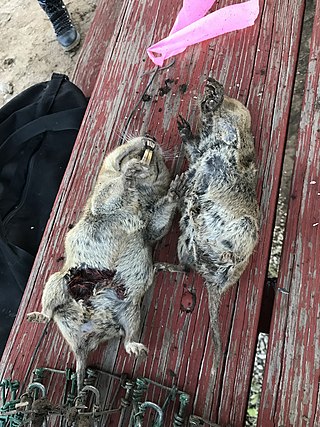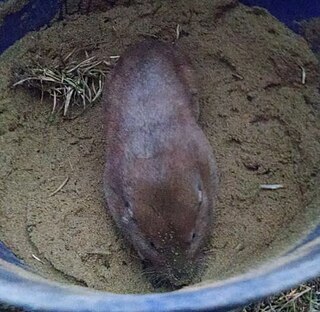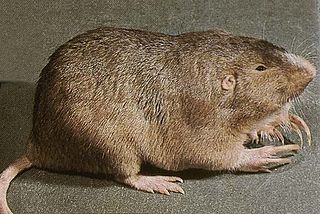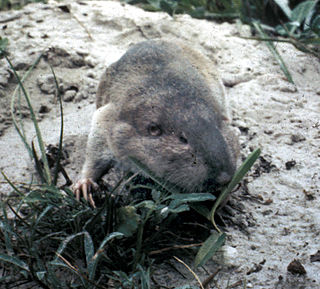
Vespertilionidae is a family of microbats, of the order Chiroptera, flying, insect-eating mammals variously described as the common, vesper, or simple nosed bats. The vespertilionid family is the most diverse and widely distributed of bat families, specialised in many forms to occupy a range of habitats and ecological circumstances, and it is frequently observed or the subject of research. The facial features of the species are often simple, as they mainly rely on vocally emitted echolocation. The tails of the species are enclosed by the lower flight membranes between the legs. Over 300 species are distributed all over the world, on every continent except Antarctica. It owes its name to the genus Vespertilio, which takes its name from a word for bat, vespertilio, derived from the Latin term vesper meaning 'evening'; they are termed "evening bats" and were once referred to as "evening birds".

The Muroidea are a large superfamily of rodents, including mice, rats, voles, hamsters, lemmings, gerbils, and many other relatives. Although the Muroidea originated in Eurasia, they occupy a vast variety of habitats on every continent except Antarctica. Some authorities have placed all members of this group into a single family, Muridae, due to difficulties in determining how the subfamilies are related to one another. Many of the families within the Muroidea superfamily have more variations between the families than between the different clades. A possible explanation for the variations in rodents is because of the location of these rodents; these changes could have been due to radiation or the overall environment they migrated to or originated in. The following taxonomy is based on recent well-supported molecular phylogenies.

The smooth-toothed pocket gophers, genus Thomomys, are so called because they are among the only pocket gophers without grooves on their incisors. They are also called the western pocket gophers because they are distributed in western North America. They are considered distinct enough from other pocket gophers to be recognized as a separate subfamily or tribe.

The yellow-faced pocket gopher is a species of pocket gopher that is native to shortgrass prairies in the south-western United States and northern Mexico. It is the species that lives north of the Southern Coahuila Filter-Barrier (SCFB). Among the different species, the yellow-faced pocket gopher has a small to medium-sized skull. The fossil of this genus was recorded from the pre-Pleistocene Benson Beds of Arizona.

The southeastern pocket gopher is a species of pocket gopher that is native to the southeastern United States. It occurs in Alabama, Georgia, and Florida, where it is the only pocket gopher.

The genus Geomys contains 12 species of pocket gophers often collectively referred to as the eastern pocket gophers. Like all pocket gophers, members of this genus are fossorial herbivores.

The desert pocket gopher is a species of rodent in the family Geomyidae. It is found in the state of Chihuahua in Mexico and in Texas and New Mexico in the United States.

The plains pocket gopher is one of 35 species of pocket gophers, so named in reference to their externally located, fur-lined cheek pouches. They are burrowing animals, found in grasslands and agricultural land across the Great Plains of North America, from Manitoba to Texas. Pocket gophers are the most highly fossorial rodents found in North America.

The Texas pocket gopher is a species of rodent in the family Geomyidae. It is found in Tamaulipas in Mexico and in Texas in the United States.
The central Texas pocket gopher or Llano pocket gopher is a species of rodent in the family Geomyidae. It is endemic to central Texas in the United States.
Buller's pocket gopher is a species of gopher that is endemic to Mexico.

Merriam's pocket gopher is a species of rodent in the family Geomyidae. It is endemic to Mexico, where it is found in the area of the Valley of Mexico and the Valley of Toluca at elevations from 1800 to 4000 m. Its favored habitats are the Zacatonal grassland and temperate pine-oak woodlands, as well as farmland and rangeland. Its karyotype has 2n = 36 and FN = 68.

The Wyoming pocket gopher is a species of gopher that is endemic to the United States. Between 1915 and 1979, it was generally considered to be a subspecies of the northern pocket gopher.

Baird's pocket gopher or the Louisiana pocket gopher is a species of pocket gopher that is native to the southern United States. In total, there are three almost identical species of eastern pocket gopher; Geomys attwateri, G. bursarius, and G. breviceps. G. breviceps is larger in size, G. attwateri is medium-sized and G. bursarius is a bit smaller. Other than by size variation they are not identifiable by external features. Baird's pocket gophers are small rodents with most of their weight on the top half of their bodies.
Knox Jones's pocket gopher is a species of pocket gopher found in Texas and New Mexico. This species is named for Dr. J. Knox Jones Jr. (1929–1992), a prolific mammalogist at Texas Tech University.

The Rio Grande ground squirrel is a species of squirrel in the family Sciuridae. It is found in the south-western United States and in north-eastern Mexico.

The Oriental Basin pocket gopher is a species of pocket gopher which is endemic to Mexico. It was first described in 1895 by Clinton Hart Merriam. It was considered to be a subspecies of Merriam's pocket gopher in the late 20th and early 21st century but has been reinstated as its own species. The IUCN Red List has evaluated it to be of least concern.
The Perote pocket gopher, or Cofre de Perote pocket gopher, is a species of pocket gopher in the family Geomyidae.
Geomys jugossicularis, also known as Hall's pocket gopher and Colorado pocket gopher, is a species of pocket gopher native to the western United States. Little is known of its behavior or ecology aside from typical behaviors of the other pocket gophers.
Geomys streckeri, also known as Strecker's pocket gopher, is a species of pocket gopher found in Texas. It was formerly considered a subspecies of the Texas pocket gopher. Chromosomal analyses have proven this species to be distinct. Analysis of its mitochondrial cytochrome b points to this species being a sister clade to Geomys personatus, Geomys attwateri, and Geomys tropicalis. Other evidence, using a Bayesian analysis of ribosomal RNA and certain proteins, points to it being embedded within the G. personatus clade and being a sister species to G. attwateri.













